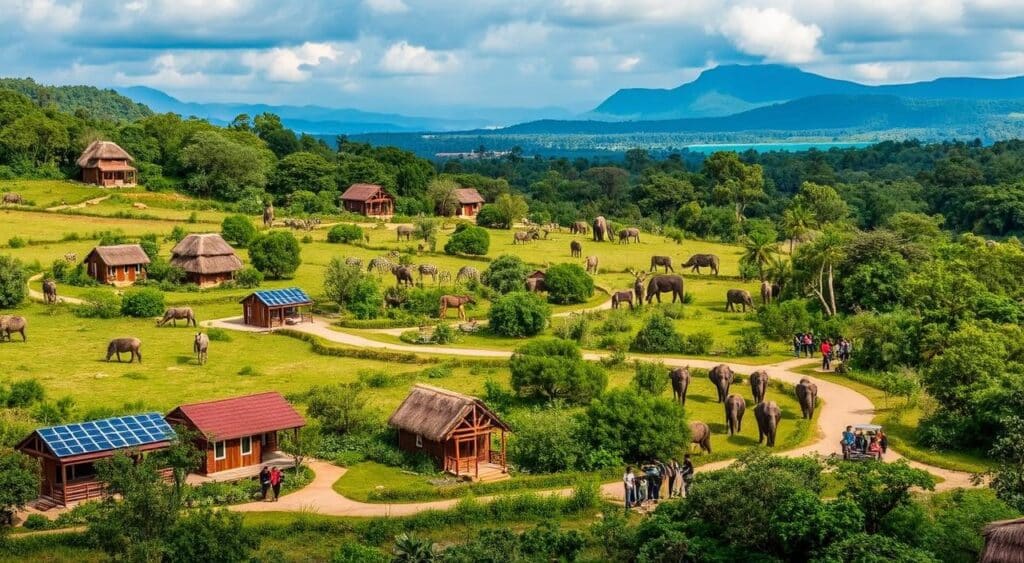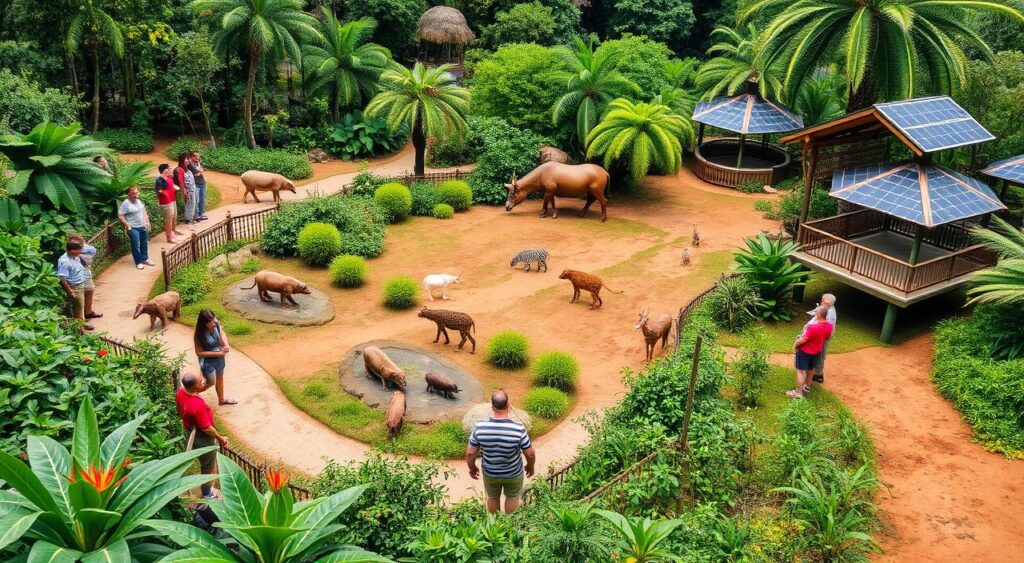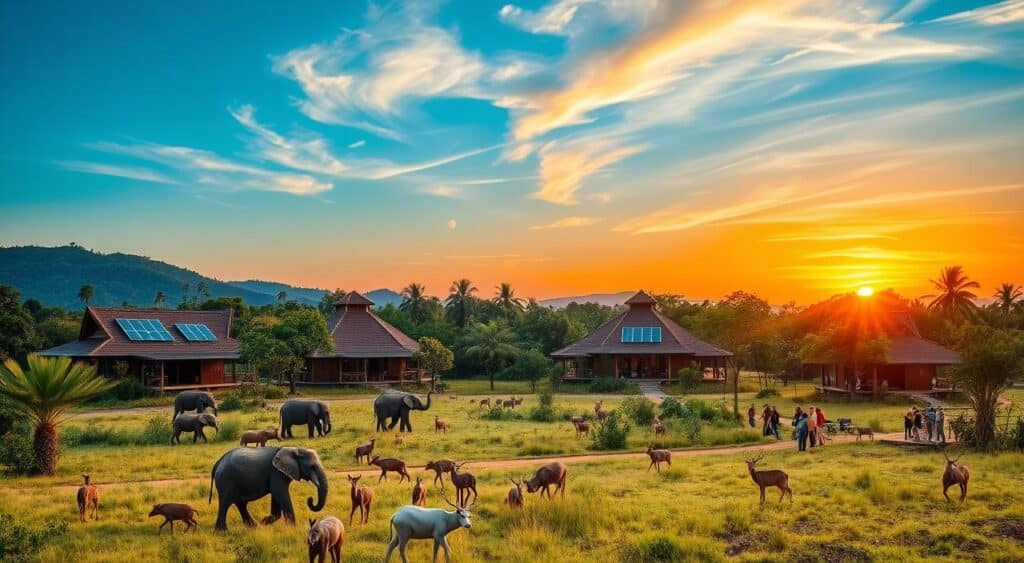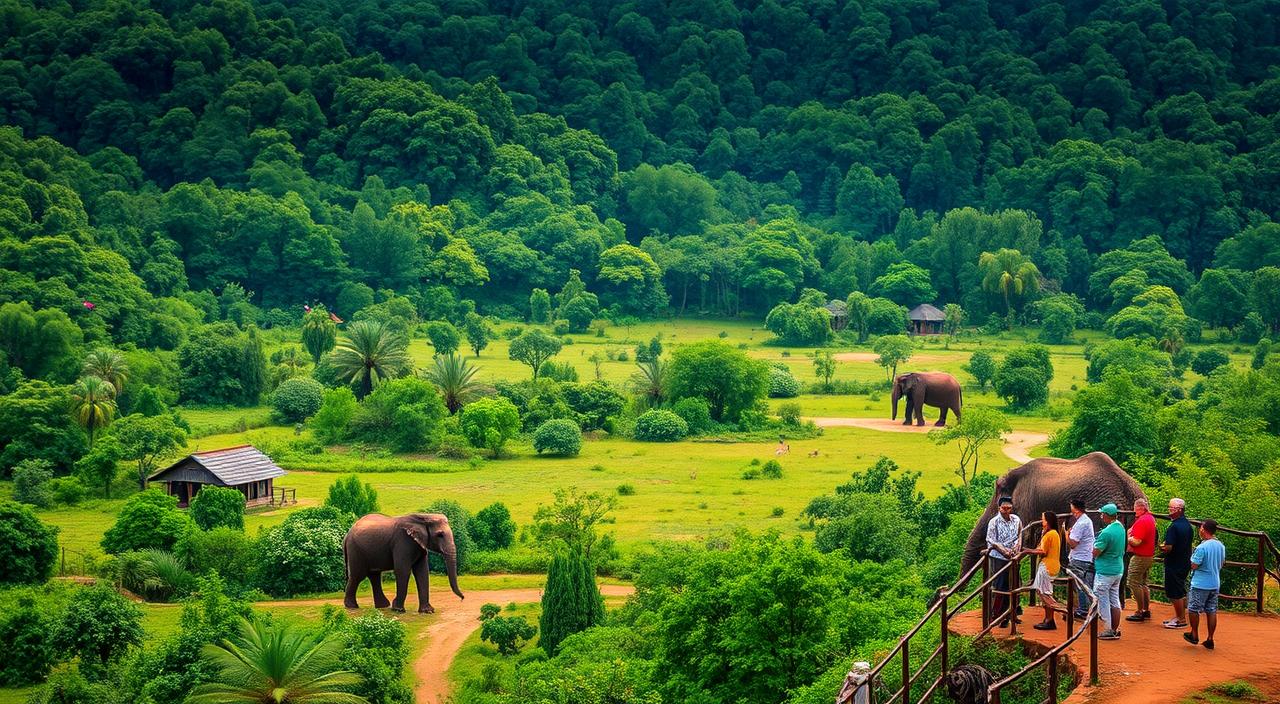The tourism industry is key for economic growth, cultural exchange, and jobs. But, it can harm the environment, causing damage to habitats and pollution. Sustainable wildlife tourism aims to protect nature and culture for the future by balancing tourism and ecology.
This approach tries to reduce tourism’s harm while boosting its good for local areas and nature. It requires careful planning to avoid harming ecosystems. Sustainable wildlife tourism encourages travel that respects and preserves natural and cultural treasures.
Key Takeaways
- Sustainable wildlife tourism aims to lessen tourism’s harm on nature while benefiting local communities.
- It needs careful planning to avoid harming ecosystems or depleting resources.
- It promotes travel that respects and preserves natural and cultural heritage.
- It’s important to balance tourism’s needs with nature’s preservation for sustainable growth.
- Sustainable wildlife tourism can help the economy while protecting fragile ecosystems.
Understanding Sustainable Wildlife Tourism
Sustainable wildlife tourism aims to meet the needs of tourism while protecting nature and wildlife. It’s vital as global travel increases, putting pressure on places and harming the environment.
Importance of Sustainable Wildlife Tourism
The role of sustainable wildlife tourism is huge. It helps protect areas and supports jobs worldwide. It also boosts tourism spending, but we must ensure it doesn’t harm wildlife.
This type of tourism promotes responsible travel. It helps visitors respect and care for the places they see. By doing so, it supports conservation and helps wildlife and their homes thrive.
- Predicted international demand for sustainable wildlife tourism: 12 million outings annually with an average yearly increase of 10%
- Estimated global value of the wildlife tourism industry: approximately 30 billion pounds
- Number of tourists booking wildlife safaris up to 90 days in advance, leading to quick sell-outs
But, tourism can also harm wildlife. Over 500,000 wild animals face abuse or cruelty because of it. We need sustainable practices to make tourism positive for both people and nature.
“Sustainable wildlife tourism is not just a concept, but a necessity in the face of growing global travel and the urgent need to protect our planet’s biodiversity.”
Economic Benefits of Sustainable Wildlife Tourism

Sustainable wildlife tourism boosts the economy by drawing in eco-aware visitors. These visitors are ready to spend more for green experiences. This tourism supports local businesses, like eco-lodges and restaurants, and tours that focus on saving wildlife.
Investing in green tourism infrastructure helps communities grow economically without harming nature. Wildlife tourism can bring in a lot of money and jobs, helping the local economy.
Visitors to wildlife spots spend on places to stay, food, and activities. This helps small businesses grow and creates jobs. The money from green wildlife tourism also goes back into protecting habitats and funding research.
| Sustainable Tourism Benefits | Economic Value |
|---|---|
| Tourism to protected areas | Attracts approximately 8 billion visits in a typical year |
| Wildlife tourism global impact | Supports nearly 22 million jobs and contributes over $120 billion to global GDP |
| Coral reef tourism value | Generates $36 billion in global tourism value per year |
| Marine-based tourism in Galapagos | Worth over $178 million per year and supports over a third of all jobs |
| Gorilla trekking permits in Uganda | Start at $600, with the economic value estimated at $34.3 million |
The COVID-19 pandemic hit the tourism world hard. Yet, the lasting good of green wildlife tourism is clear. By choosing eco-friendly travel, we help save nature and grow the economy. This also creates lasting jobs for local people.
Sustainable Wildlife Tourism: Protecting Biodiversity

Sustainable wildlife tourism is key to keeping our planet’s ecosystems in balance. It helps reduce the tourism industry’s carbon footprint. This way, it protects the homes of endangered species.
By using eco-friendly practices, tourism can make a big difference. It can switch to renewable energy and promote green transport. This has many ecological benefits.
Conservation efforts backed by sustainable tourism are vital for wildlife. They protect the habitats of animals like tigers, elephants, and whales. This ensures their survival for future generations.
Sustainable tourism also raises awareness about environmental issues. It encourages visitors to live greener and support conservation.
Challenges in Implementing Sustainable Wildlife Tourism
Starting sustainable wildlife tourism is not easy. It needs a lot of investment in new infrastructure. This can be hard for some operators.
There’s also resistance from those who don’t want to change. They might not see the need for greener practices.
Measuring the success of sustainable tourism is tricky. It needs good monitoring and reporting. A clear plan is essential for real change.
| Sustainable Wildlife Tourism Initiatives | Key Benefits |
|---|---|
| The Global Wildlife Program (GWP) | Promoting wildlife conservation and sustainable development in 19 countries across Africa and Asia with a $131 million grant from the Global Environment Facility (GEF). |
| Ruaha Carnivore Project in Tanzania | Utilizing a payment for ecosystem services (PES) scheme to combine wildlife conservation and community benefits effectively. |
| Community Conservancies in Namibia | Managing land for wildlife and implementing profit-sharing commercial tourism arrangements to ensure the benefits of tourism flow to local communities. |
Beating these challenges needs teamwork. Governments, industries, and local communities must work together. By doing so, we can make wildlife tourism a positive force. It will help our planet’s ecosystems thrive.
Strategies for Promoting Sustainable Wildlife Tourism

The tourism industry is growing fast. It’s important to use strategies that support sustainable wildlife tourism. This way, we can meet the needs of travelers while protecting natural habitats and wildlife.
Governments can help a lot by making policies and regulations that encourage sustainable practices. They can offer tax breaks for eco-friendly accommodations and tour operators. At the same time, they can enforce stricter rules on harmful activities.
Teaching travelers about sustainability is key. We need to educate them on how they can help with responsible wildlife tourism. This can be done through campaigns and educational programs that show the impact of tourism on wildlife.
It’s also important to involve local communities in planning wildlife tourism projects. This way, we make sure their needs and concerns are heard. It leads to better outcomes for both local people and the natural environment.
Finally, certification programs for eco-friendly accommodations and tour operators are helpful. They help travelers find sustainable wildlife tourism options. These programs have high standards for animal welfare, conservation efforts, and sustainable practices.
By using these strategies, the tourism industry can be a force for good. It can support sustainable development and conservation. At the same time, it offers travelers unique and ethical wildlife experiences.
Also Read: How Can Individuals Contribute To Nature Conservation Efforts?
Conclusion
Sustainable wildlife tourism is a way to grow the economy while keeping our planet healthy. It lets the tourism industry grow without harming nature. Everyone involved must work together to make tourism good for both people and the planet.
This approach to tourism can bring in money and protect animals and plants. But, we face challenges like not enough knowledge, money, and wildlife disturbance. We need to teach tourists, help local areas financially, and support eco-friendly tourism.
In the end, sustainable wildlife tourism can help our planet and local communities. It’s about caring for wildlife and nature. As we go forward, it’s key for everyone in tourism to adopt green practices. This way, we can make sure wildlife and tourism live together peacefully.
FAQs
Q: What is sustainable wildlife tourism and how does it relate to conservation?
A: Sustainable wildlife tourism refers to tourism activities that are designed to observe wild animals in their natural habitats while ensuring the conservation of wildlife and their habitats. This form of tourism promotes responsible practices that protect wildlife and contribute to the sustainable development goals, fostering a balance between tourism and ecological preservation.
Q: How can tourism development negatively impact wildlife populations?
A: Tourism development can lead to habitat destruction, pollution, and increased human-wildlife conflict, which can have a negative impact on wildlife populations. Unsustainable tourism practices can disturb natural ecosystems, disrupt breeding patterns, and decrease the availability of food for wild animals.
Q: What role do local communities play in sustainable tourism practices?
A: Local communities are essential in sustainable tourism practices as they often serve as custodians of the natural environment. Engaging local communities in tourism initiatives not only provides them with sustainable livelihoods but also ensures that tourism activities benefit wildlife and help conserve local ecosystems.
Q: How does ecotourism differ from traditional tourism?
A: Ecotourism focuses on responsible travel to natural areas, aiming to conserve the environment and improve the well-being of local communities. Unlike traditional tourism, which may prioritize profit over sustainability, ecotourism emphasizes sustainable practices that minimize the negative impact on wildlife and their habitats.
Q: What are some examples of sustainable wildlife tourism products?
A: Examples of sustainable wildlife tourism products include wildlife safaris that prioritize ethical wildlife viewing, guided tours in national parks that contribute to conservation efforts, and experiences that support local artisans and communities. These products are designed to provide enjoyable experiences while benefiting wildlife and their habitats.
Q: How can travelers engage in responsible tourism while observing wildlife?
A: Travelers can engage in responsible tourism by choosing ethical wildlife tourism operators, following guidelines for observing wildlife, and respecting natural habitats. It’s important to avoid disturbing animals and to support initiatives that contribute to the conservation of wildlife populations and their environments.
Q: What are the positive impacts of wildlife tourism on conservation efforts?
A: Wildlife tourism can have a positive impact on conservation efforts by generating funding for protected areas, raising awareness about endangered species, and fostering a connection between tourists and wildlife. This financial support can help maintain national parks and wildlife sanctuaries, ensuring the protection of wildlife and their habitats.
Q: What initiatives are in place to promote sustainable practices in wildlife tourism?
A: Various initiatives aim to promote sustainable practices in wildlife tourism, such as certification programs for eco-friendly operators, community-based tourism projects, and partnerships between conservation organizations and the travel industry. These initiatives encourage responsible tourism activities and help protect wildlife while contributing to local economies.
Q: How can sustainable travel contribute to the sustainable development goals?
A: Sustainable travel can contribute to the sustainable development goals by promoting environmental stewardship, supporting local communities, and fostering economic growth through responsible tourism practices. By prioritizing sustainability in travel, we can help achieve goals related to poverty alleviation, biodiversity conservation, and climate action.

